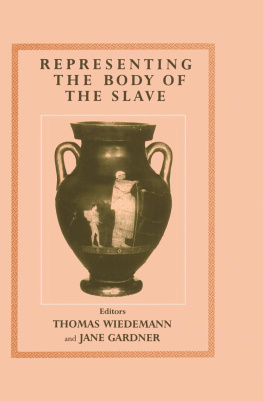STUDIES IN SLAVE AND POST-SLAVE SOCIETIES AND CULTURES
Series Editors: Gad Heuman and James Walvin
REPRESENTING THE BODY OF THE SLAVE
STUDIES IN SLAVE AND POST-SLAVE SOCIETIES AND CULTURES
Series Editors: Gad Heuman and James Walvin
ISSN 1462-1770
Other Titles in the Series
Unfree Labour in the Development of the Atlantic World
edited by Paul E. Lovejoy and Nicholas Rogers
Small Islands, Large Questions
Society, Culture and Resistance in the Post-Emancipation Caribbean edited by Karen Fog Olwig
Reconstructing the Black Past
Blacks in Britain 1780-1830 by Norma Myers
Against the Odds
Free Blacks in the Slave Societies of the Americas edited by Jane G. Landers
Routes to Slavery
Direction, Ethnicity and Mortality in the Atlantic Slave Trade edited by David Eltis and David Richardson
Popular Politics and British Anti-Slavery
The Mobilisation of Public Opinion against the Slave Trade, 17871807 by J.R. Oldfield
Classical Slavery
by M.I. Finley
Slavery and Colonial Rule in Africa
edited by Suzanne Miers and Martin Klein
From Slavery to Emancipation in the Atlantic World
edited by Sylvia R. Frey and Betty Wood
After Slavery
edited by Howard Temperley
Rethinking the African Diaspora
The Making of a Black Atlantic World in the Bight of Benin and Brazil edited by Kristin Mann and Edna G. Bay
Representing the Body of the Slave
Editors
THOMAS WIEDEMANN
University of Nottingham
JANE GARDNER
Universities of Reading and Nottingham
First published in 2002 in by
FRANK CASS PUBLISHERS
This edition published 2013 by Routledge
711 Third Avenue, New York, NY 10017
2 Park Square, Milton Park, Abingdon, Oxon OX14 4RN
Routledge is an imprint of the Taylor & Francis Group, an informa business
Copyright 2002 Frank Cass Publishers
British Library Cataloguing in Publication Data
Representing the body of the slave. (Studies in slave and post-slave societies and cultures)
1.Slavery in art 2.Slavery in literature
I. Wiedemann, Thomas II. Gardner, Jane F., 1934-
700.4520625
ISBN 0-7146-5351-9
ISBN 0-7146-8288-8
ISSN 1462-1770
Library of Congress Cataloging-in-Publication Data
Representing the body of the slave / editors, Thomas Wiedemann and Jane Gardner.
p. cm. (Studies in slave and post-slave societies and cultures, ISSN 1462-1770)
First appeared as a special issue of Slavery and abolition, vol. 23, no. 2, August 2002Verso t.p.
ISBN 0-7146-5351-9 (hardback) ISBN 0-7146-8288-8 (pbk.)
1. SlaveryHistory. 2. SlavesPublic opinionHistory. 3. Slavery in literature. 4. Slavery in art. I. Wiedemann, Thomas E. J. II. Gardner, Jane F. III. Slavery & abolition. IV. Series.
HT861 .R47 2002
305.567 dc21
2002007003
This group of studies first appeared as a special issue of Slavery and Abolition, Vol.23, No.2, August 2002, published by Frank Cass.
All rights reserved. No part of this publication may be reproduced, stored or introduced into a retrieval system or transmitted, in any form or by any means, electronic, mechanical, photocopying, recording, or otherwise, without the prior written permission of the publisher of this book.
Contents
Thomas Wiedemann and Jane Gardner
Ingomar Weiler
Niall McKeown
Michele George
Ehud R. Toledano
David Pelteret
Celeste-Marie Bernier
Henrice Altink
Silvia Hunold Lara
Robert W. Slenes
Robert Krueger
Figures
. Jacob Giving Instructions to his Slave
. Labours of the Months: January Ploughing
. Carlos Julio, Elevation and Faade, Shown in Perspective, as Seen from the Sea, the City of Salvador Bahia of All Saints in Southern America
. Carlos Julio, Entry to the Bar of Goa, Prospect of Diu, Entry to Rio de Janeiro and Prospect of Mozambique Island
. Carlos Julio, Figures Illustrating the Customs of Whites and Blacks in Rio de Janeiro and Serro do Frio Plate XXX
. Carlos Julio, Figures Illustrating the Customs of Whites and Blacks in Rio de Janeiro and Serro do Frio Plate XL
. Carlos Julio, Figures Illustrating the Customs of Whites and Blacks in Rio de Janeiro and Serro do Frio Plate XXXIII
. Carlos Julio, Figures Illustrating the Customs of Whites and Blacks in Rio de Janeiro and Serro do Frio Plate XXXII
. Carlos Julio, Figures Illustrating the Customs of Whites and Blacks in Rio de Janeiro and Serro do Frio Plate XXVI
. Carlos Julio, Figures Illustrating the Customs of Whites and Blacks in Rio de Janeiro and Serro do Frio Plate XXXIV
. Carlos Julio, Figures Illustrating the customs of Whites and Blacks in Rio de Janeiro and Serro do Frio Plate XXVII
. Johann Moritz Rugendas, Burial of a Black Man in Bahia
. J.M. Rugendas, Blacks in the Ship's Hold
. J.M. Rugendas, Festival of Our Lady of the Rosary, Patroness of the Blacks
. J.M. Rugendas, Dwelling of the Blacks
. J.M. Rugendas, New Blacks
. Matthaeus Merian, Entombment of Christ (detail)
. J.M. Rugendas, Blacks in the Ship's Hold (detail)
. M. Merian, Ecce Homo (detail)
. M. Merian, Burial of Abraham
Tables
. Facts Bearing upon Production of Brazilian Slave Texts
. Condensed Inventory of Brazilian Slave Texts
. Comparative Modes of Brazilian Slave Text Production
ICHOS (the International Centre for the History of Slavery) was set up at the University of Nottingham, England, in 1998. The project was initiated by staff in the Department of Classics, which contains a number of social historians, including Professor Thomas Wiedemann and Special Professor Jane Gardner (Emeritus Professor of Ancient History at Reading University). Support was also forthcoming from colleagues in the School of American and Canadian Studies, and from a number of departments, especially History, Theology and Hispanic and Latin American Studies.
ICHOS sees its primary function as serving the academic study of the history of slavery by encouraging the international and interdisciplinary exchange of ideas; particularly important has been the development of existing links with scholars in other countries, and with comparable bodies such as the Gilder Lehrman Center at Yale and the Mainz Akademie project for the study of Greek and Roman slavery.
The essays in this volume are by participants in the first of a planned series of international and interdisciplinary conferences, held by ICHOS at the University of Nottingham, 1113 September 2000. The theme was Representing the Body of the Slave.
THOMAS WIEDEMANN and JANE GARDNER
Contributors to this collection of essays examine how the bodies of slaves have been written or spoken about or depicted in art in different times, cultures and parts of the world ancient Greece and Rome, early medieval Britain, the Ottoman Empire, North America, the Caribbean and Brazil.
Much of this source material is highly revelatory of the attitudes of those who initially created it, and who intended to influence others. Not surprisingly, members of the slave-owning society were generally concerned to distinguish sharply between free and slave, and implicitly to justify the institution of slavery, by asserting the natural inferiority of slaves. Abolitionists, on the other hand, stressed the slaves essential humanity, and even nobility, and deplored the brutality and cruelty with which they were treated. So too, did the comments of ex-slaves themselves. Narratives of this type by former slaves in North America are already well known; it is exciting to learn of the autobiographic material from former slaves in Brazil that, as reported by Krueger, current research is unearthing.












![Lyn Gardner [Lyn Gardner] - Rose Campion and the Christmas Mystery](/uploads/posts/book/141372/thumbs/lyn-gardner-lyn-gardner-rose-campion-and-the.jpg)

